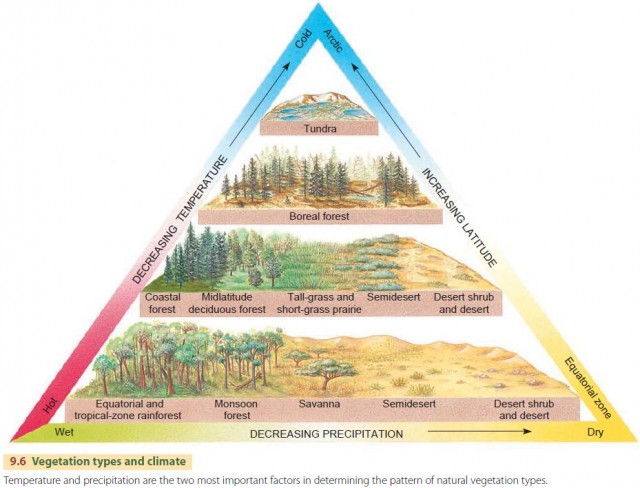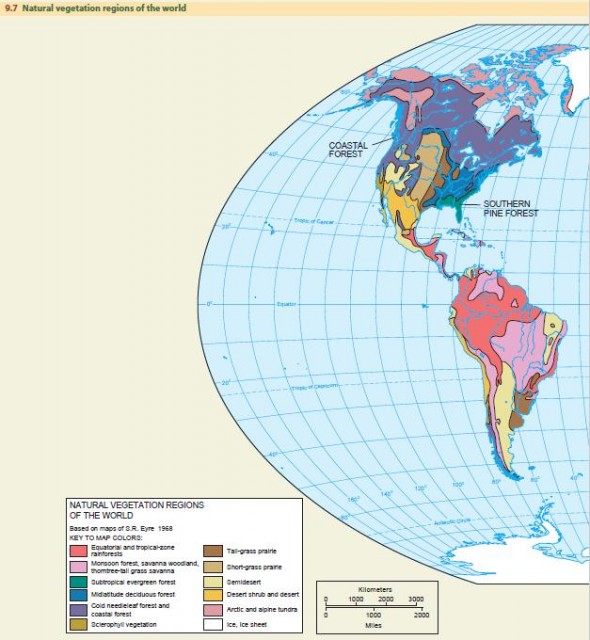Terrestrial Ecosystems — The Biomes
For humans, ecosystems are great natural factories producing food, fiber, fuel, and structural material. These useful products are manufactured by organisms using energy from the Sun, and we harvest that energy by using these ecosystem products. The products and productivity of ecosystems depend on their climate. Where temperature and rainfall cycles permit, ecosystems provide a rich bounty. Where temperature or rainfall cycles restrict ecosystems, human activities can also be limited. Of course, humans are also part of the ecosystems that we modify for our own benefit.
Ecosystems fall into two major groups—aquatic and terrestrial. Aquatic ecosystems include marine environments and the freshwater environments of the lands. Marine ecosystems include the open ocean, coastal estuaries, and coral reefs. Freshwater ecosystems include lakes, ponds, streams, marshes, and bogs. In this book, we'll focus on the terrestrial ecosystems, which are dominated by land plants spread widely over the upland surfaces of the continents. The terrestrial ecosystems are directly influenced by climate, so they are closely woven into the fabric of physical geography.
We divide terrestrial ecosystems into biomes. Although the biome includes both plant and animal life, green plants dominate the biome simply because of their enormous biomass. Plant geographers concentrate on the characteristic life-form of the green plants within the biome—principally trees, shrubs, lianas, and herbs—but also other life-forms in certain biomes.
There are five principal biomes. The forest biome is dominated by trees, which form a closed or nearly closed canopy. Forest requires an abundance of soil water, so forests are found in moist climates. Temperatures must also be suitable, requiring at least a warm season, if not warm temperatures the year round. The savanna biome is transitional between forest and grassland. It exhibits an open cover of trees with grasses and herbs underneath.
The grassland biome develops in regions with moderate shortages of soil water. The semiarid regions of the dry tropical, dry subtropical, and dry midlatitude climates are the home of the grassland biome. Temperatures must also provide adequate warmth during the growing season.
The desert biome includes organisms that can survive a moderate to severe water shortage for most, if not all, of the year. Temperatures can range from very hot to cool. Plants are often xerophytes, showing adaptations to the dry environment. The tundra biome is limited by cold temperatures. Only small plants that can grow quickly when temperatures warm above freezing in the warmest month or two can survive.
Biogeographers break the biomes down farther into smaller vegetation units, called formation classes, using the life-form of the plants. For example, at least four and perhaps as many as six kinds of forests can be distinguished within the forest biome. At least three kinds of grasslands are easily recognizable. Deserts, too, span a wide range in terms of the abundance and life-form of plants. The formation classes described in the remaining portion of this chapter are major, widespread types that are clearly associated with specific climate types.
BIOMES, FORMATION CLASSES, AND CLIMATE
The pattern of formation classes depends heavily on climate. As climate changes with latitude or longitude, vegetation will also change. Figure 9.6 shows how vegetation formation classes respond to temperature and precipitation gradients. In both low- and midlatitude environments, strong precipitation gradients produce vegetation types grading from forest to desert. At high latitudes, decreasing temperatures control the transition from forest to tundra.

The diagram does not include seasonality. In low latitudes, savanna and grassland formation classes are found in regions with a distinct dry season. In the midlatitudes, west coasts are marked with a strong summer dry period, providing sclerophyll vegetation (not shown) in coastal regions and, farther poleward, encouraging the growth of lush coastal forests of conifers.
Figure 9.7 is a generalized world map of vegetation formation classes. It simplifies the very complex patterns of natural vegetation to show large uniform regions in which a given formation class might be expected to occur. Although the boundaries between vegetation types are shown as distinct lines, many real boundaries are gradational and located approximately.

